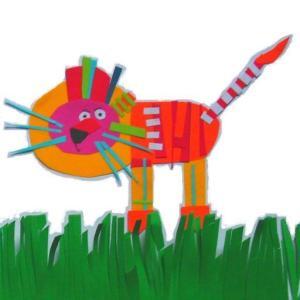L’aritmetica Waldorf si fonda sul principio di un insegnamento artistico ed immaginativo: l’impressione visiva è importantissima anche nella presentazione delle quattro operazioni in prima classe…
Per la matematica è importante che l’aula sia preparata: soprattutto è importante che ci siano poche decorazioni, molto spazio per i giochi di movimento, e ordine. Contare è un processo spaziale e ritmico. Il movimento è alla base dell’apprendimento della matematica. Noi non possiamo insegnare, dobbiamo creare le condizioni per poter imparare. Dobbiamo creare fame e sete per i numeri.
Ricordiamo sempre che non ci sono persone che non sono capaci di fare matematica, ma spesso si trovano persone che hanno paura della matematica, o della musica. Quindi il grande compito degli insegnanti nei primi anni di scuola è proprio quello di togliere la paura della matematica. I bambini che non riescono, devono poter nuotare nella corrente della classe, perchè ogni classe è in realtà una pluriclasse, e le tappe di sviluppo dei bambini non sono affatto correlate automaticamente ad un data fascia d’età. E’ vero che nel nostro sistema scolastico ci sono livelli normativi da raggiungere, ma noi dobbiamo sempre fare il possibile per dare ad ognuno il proprio tempo. Consideriamo sempre che ci sono grandi differenze individuali, e momenti di accelerazione improvvisi nello sviluppo delle abilità dei bambini. Nei momenti in cui il bambino sembra essere “indietro”, soprattutto cerchiamo di non essere noi a generare in lui la paura verso la matematica. All’inizio i bambini si aiutano a vicenda, e noi dobbiamo accettare il fatto che arrivino in momenti diversi.
Configurando l’insegnamento in modo artistico, facciamo leva sui sensi del bambino perchè lui possa imparare con entusiasmo e sempre rinnovata curiosità. Coi bambini piccoli l’aritmetica, nella scuola Waldorf, è utilizzata anche per dare immagini di altruismo e bellezza. Soprattutto, comunque, tenete presente che la matematica ha bisogno di grande chiarezza, e che gli esercizi che proponiamo devono variare il più possibile.
Con l’insegnamento della matematica vogliamo:
– imparare a vivere insieme
– imparare a conoscere (non a sapere)
– imparare a fare
– imparare ad essere.
Nel preparare gli esercizi, inoltre, cerchiamo sempre di proporre prima i più semplici, andando via via verso quelli più complessi. Quando tutti i bambini sono in grado di svolgere gli esercizi più semplici, possiamo anche considerare che qualche bambino è pronto per qualcosa di più impegnativo, e possiamo in aggiunta proporre esercizi facoltativi e differenziare i gradi di difficoltà.
Per questi giochi è importante disegnare alla lavagna al momento, davanti ai bambini, perchè il processo è interessante più del risultato. Spesso la paura della matematica è generata da insegnanti e genitori che danno più importanza al risultato che non al processo.
Negli esempi che seguono ho utilizzato i famosi gnomi della matematica Waldorf (verde, blu, giallo e rosso).
Per l’addizione partiamo dal tutto per arrivare alle parti.
Nel mondo reale, infatti, noi percepiamo prima l’unità, e poi i particolari. Ad esempio vediamo prima il bosco, e poi gli alberi. Per questo esercizio disegnamo un prato con delle pecorelle. Quante sono? Nove.
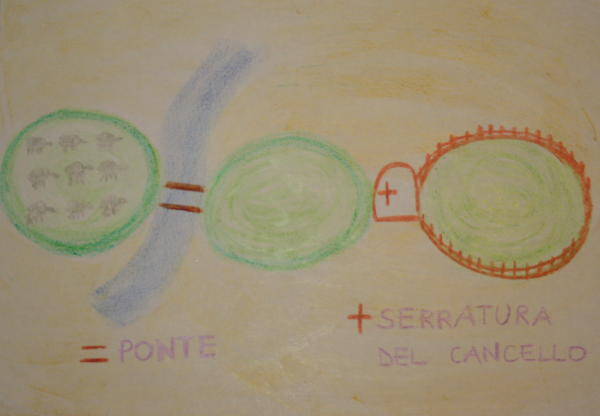
C’è un piccolo ponte su un ruscello, e tutte e nove le pecorelle vanno a distribuirsi un po’ nel primo prato, e un po’ oltre il cancello con la serratura, nel recinto.
Quante pecorelle potranno esserci nel primo prato, e quante nel recinto? (ad esempio 5+4, 4+5, 1+8, ecc…)
Per quanto riguarda i temperamenti, l’addizione è l’operazione più adatta al flemmatico.
Per la sottrazione
disegniamo un uomo che va al mercato con un sacco sulle spalle che contiene 12 mele. Il sacco si taglia, e ne escono alcune. Il contadino arriva al mercato ed ha soltanto 7 mele. Quante ne ha perse?
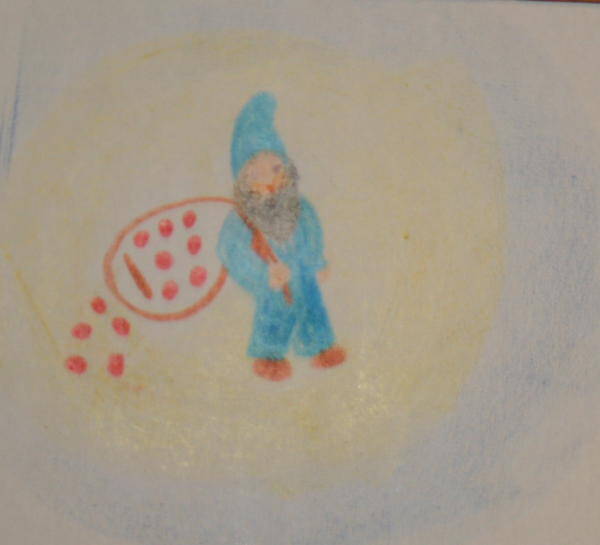
Partiamo dal risultato, e poi ricaviamo ciò che abbiamo perduto. Poi possiamo fare anche il contrario: è importante che al bambino vengano offerti più modi diversi per fare la stessa cosa.
Per quanto riguarda i temperamenti, la sottrazione è l’operazione più adatta al malinconico.
____________
Per la moltiplicazione
disegniamo un giocoliere che ha a disposizione nove palline in tutto. Lui gioca con tre palline alla volta, e ogni volta che gli cadono può prenderne altre tre e ricominciare. Per quante volte? (9= 3 x ?).
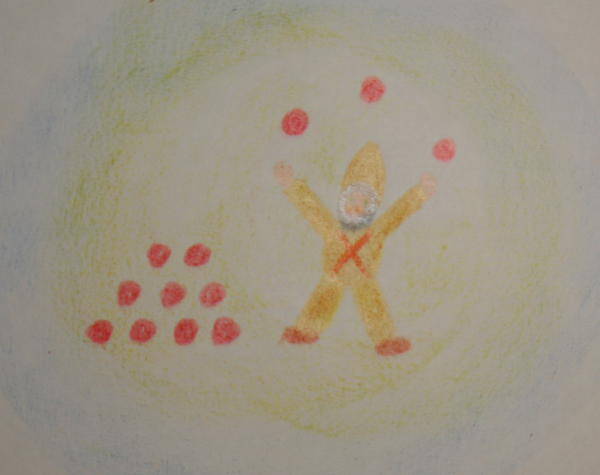
Si possono trovare altri esempi, e poi fare anche l’inverso (3 x 3 = ?)
Per quanto riguarda i temperamenti, la moltiplicazione è l’operazione più adatta al sanguinico.
________________
Divisione e moltiplicazione sono molto legate tra loro.
In questo esercizio vogliamo fare tre mucchi di biglie. Le biglie sono in tutto 9. Come posso fare per avere tre mucchi uguali?
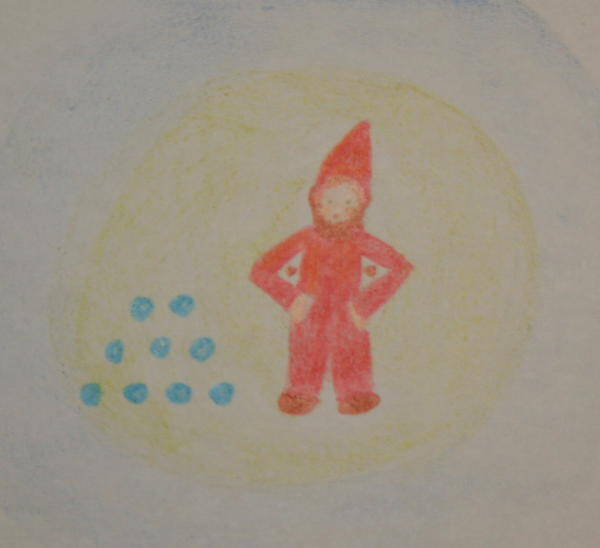
Per quanto riguarda i temperamenti, la divisione è l’operazione più adatta al collerico.

Waldorf arithmetic: first exercises with the four operations. The Waldorf arithmetic is based on the principle of an artistic and imaginative teaching: the visual impression is very important also in the presentation of the four operations in first class.
For mathematics is important that the classroom is prepared: it is especially important that there are few decorations, plenty of space for games of movement, and order. Count is a process spatial and rhythmic. The movement is the basis of mathematics learning. We can not teach, we must create the conditions for learning. We need to create hunger and thirst for numbers.
Let us always remember that there are no people that are not capable of doing mathematics, but often you will find people who are afraid of mathematics, or music.
So the great task of teachers in the early years of school is just to remove the fear of mathematics.
Children who fail, have to swim in the current of the class, because every class is actually a multi-classes, and milestones of child development are not automatically related to a given age group.
It is true that in our school system there are regulatory levels to achieve, but we must always do everything possible to give everyone their time.
Always we consider that there are large individual differences, and moments of sudden acceleration in the development of children’s skills. At times when the child appears to be “back”, especially try not to be us to generate in him the fear of mathematics. At first the children help each other, and we must accept the fact that they arrive at different times.
By configuring the teaching in an artistic way, we leverage on the senses of the child so that he can learn with enthusiasm and always renewed curiosity. With small children arithmetic, in the Waldorf School, is also used to make images of altruism and beauty. Above all, however, keep in mind that mathematics needs very clearly, and that the exercises that we propose should vary as much as possible.
With the teaching of mathematics we want:
– learn to live together
– learn to know
– learn to do
– learn to be.
In preparing the exercises, also, we always try to first propose the simplest, going gradually to more complex ones. When all children are able to perform the simplest exercises, we can also consider that some child is ready for something more challenging, and in addition we can offer optional exercises and differentiate degrees of difficulty.
For these games it is important to draw on the blackboard at the time, in front of children, because the process is interesting most of the result. Often the fear of mathematics is created by teachers and parents that give more importance to the results than to the process.
In the following examples I used the famous gnomes of the Waldorf math (green, blue, yellow and red).
Waldorf arithmetic: first exercises with the four operations
For addition we start from all to get the parts.
In the real world, in fact, we perceive the unit first, and then the details. For example we see first the wood, and then the trees. For this exercise, we draw a meadow with some sheep. How many? Nine.

= PONTE (bridge); + SERRATURA DEL CANCELLO (gate lock)
There is a small bridge over a brook, and all nine sheep are to be distributed a bit in the first meadow, and a bit beyond the gate with the lock, in the fence.
How many sheep will there be in the first meadow, and how many in the fence? eg:
9=5 + 4
9= 4 + 5
9= 1 + 8
etc…
As regards the temperaments, the addition is the operation best suited to phlegmatic.
Waldorf arithmetic: first exercises with the four operations
For subtraction
We draw a gnome who goes to market with a sack on his back containing 12 apples. The bag is cut, and they come out some. The gnome arrives to the market and he has only seven apples. How many apples have lost? (12- ?= 7)

____________
Waldorf arithmetic: first exercises with the four operations
For multiplication
We draw a juggler who has available nine balls all. He played with three balls at a time, and each time they fall, he can take another three and start over. How many times? (9 = 3 x?).

You can find more examples, and then also the inverse (3 x 3 =?)
With regard to the temperaments, the multiplication is the operation best suited to sanguinic.
________________
Waldorf arithmetic: first exercises with the four operations
Division and multiplication are related one to the other
In this exercise, we want to make three piles of marbles. The balls are all over 9. How can I have three piles equal? (3= 9: ?)

With regard to the temperaments, the division is the operation best suited to the choleric.

